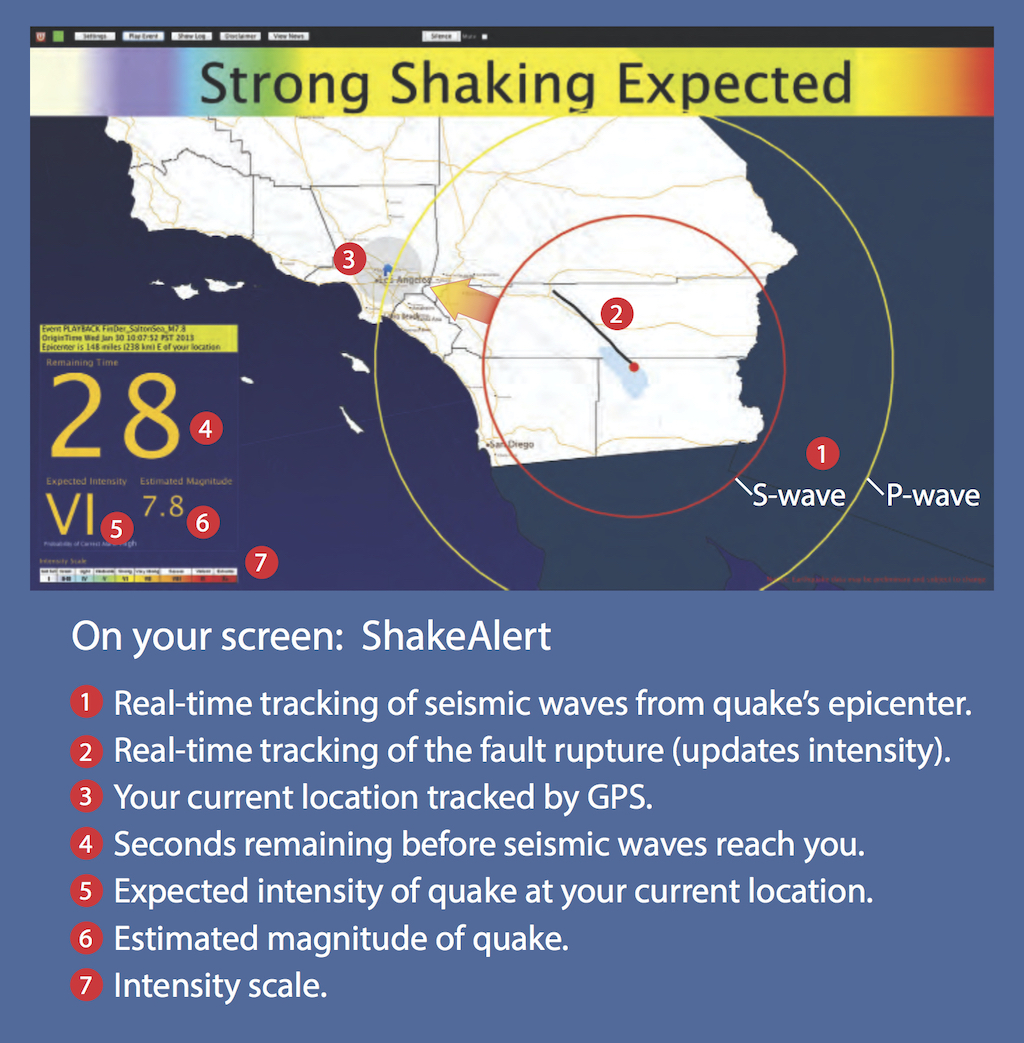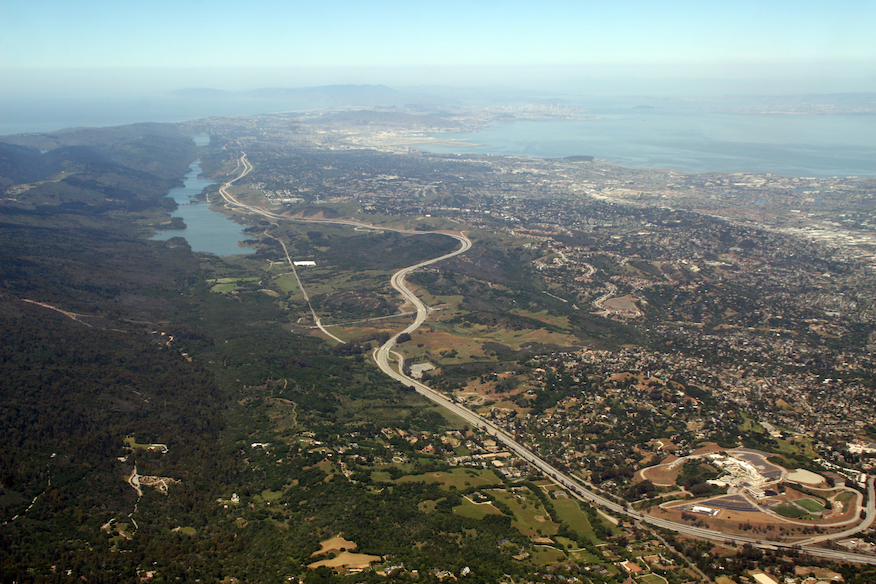By: Miguel Neves, Ph.D. Candidate, Georgia Institute of Technology (@Waves2Miguel)
A new study examines the challenges of earthquake early warning systems, such as latency, and how to improve the systems.
Citation: Neves, M., 2020, Challenges of earthquake early warning, Temblor, http://doi.org/10.32858/temblor.093
ShakeAlert, an Earthquake Early Warning (EEW) system, began sending alerts of incoming earthquake shaking to the California public in late 2019. The warning system is similar to the mechanics of a thunderstorm, says Robert-Michael de Groot, ShakeAlert National Coordinator for Communication, Education and Outreach with the U.S. Geological Survey (USGS). As lightning precedes thunder, so do an earthquake’s faster seismic waves (P waves) precede the larger and more damaging waves (S waves). EEW systems attempt to detect significant earthquakes and deliver a warning before damaging shaking arrives.

People are divided, however, on just how useful EEW systems are. Now, a recent paper in Earthquake Spectra by David Wald, a seismologist also at USGS and member of the external working group for EEW, analyzes the limitations of early warning systems and discusses how acknowledging these limitations can make the ShakeAlert system more successful.
Thirty years of EEW
EEW systems are not a new concept. Mexico City has had a public warning system since 1993 and the Japanese Meteorological Agency started issuing alerts to the public in 2007. In 2012, the USGS started the development of ShakeAlert, an EEW system for the states of California, Oregon and Washington. ShakeAlert developers have partnered with about 60 organizations in all three states, such as universities or transit authorities, that work on the development of warning applications or automatic actions (like automatically slowing down trains when an earthquake starts shaking). A ShakeAlert project pilot has been sending out alerts to partner organizations since late 2018.

The public got its first experience with the system in California last October. If the ShakeAlert system detects an earthquake with magnitude 5.0 or above, mobile phones in areas with estimated light shaking or higher (intensity IV or higher in the modified Mercalli scale) will receive an alert from FEMA through the Wireless Emergency Alerts (WEA), similar to warnings issued in the case of extreme weather or child abduction. Warnings can also reach the public through mobile apps such as MyShake or ShakeAlertLA, which can send alerts at or above magnitude 4.5 (and an intensity of III or higher). The rollout of plans for public warnings in Washington and Oregon have been impacted by the current pandemic, but experts anticipate a likely debut in the next year.
Challenge: Warning times
One of the biggest challenges EEW faces is warning times. The warning time corresponds to the time between when users receive an alert and when the shaking arrives at their location. Several media reports and EEW literature indicate that warning times can range from seconds to minutes. However, Wald notes, using estimates from idealized models provides people in areas with strong shaking only a few seconds of warning or even late warnings that arrive after the damaging waves.
The location of the earthquake is the most important factor contributing to warning time issues. If an earthquake occurs farther away from population centers, as in the cases of offshore earthquakes along the coasts of Oregon, Washington or Japan, warning times would be longer due to the larger distances. But in places like California, where the majority of earthquakes have inland origins, many people would feel the shaking before receiving an alert. There is not much that can be done to improve warning times when shaking happens directly below a person.

Hardware also has a significant impact on whether an alert arrives in advance of a major event, Wald noted. In one test in Oakland, WEA alerts showed 85 percent of phones only received alerts 5 seconds or more after the alerts were issued — which in many cases, would be too late to provide warning before shaking starts. But most mass messaging systems were not built for ShakeAlert speeds, explains de Groot. The USGS has been working with FEMA, the FCC and mobile carriers to improve WEA capabilities and make them more in line with ShakeAlert speeds. Other options for sending alerts include mobile apps such as MyShake, but Wald raises concerns these have not been tested with large numbers of users receiving an alert.
Another important component of EEW systems are the algorithms that estimate levels of ground shaking. A lot of research has been dedicated to this aspect of EEW, as these algorithms impact the warning times as well as the number of correct (and incorrect) alerts issued. ShakeAlert uses a combination of algorithms that detect and characterize an earthquake (location and magnitude) and that predict the ground shaking levels in different regions. The estimates are initially calculated in the first few seconds after the P-wave arrival but are updated as more seismic data becomes available. Many seismologists initially thought the first few seconds (about 3 seconds) would be enough to correctly assess the magnitude of a large earthquake. However, as Wald noted in his study, recent observations of earthquake onsets suggest additional time is necessary.
Nevertheless, even with additional time, the system is “still able to provide timely warnings,” says Men-Andrin Meier, a seismologist at Caltech who has studied both the ShakeAlert and the Japanese system algorithms. Recent results also suggest that improved warning times and reliability can be achieved.
Challenge: Action
What happens once a warning is received also impacts the effectiveness of EEW systems. Limited studies have been done on this, Wald reported. USGS is currently collaborating with several partners that are testing their ideas for automatic actions, such as slowing down trains, shutting down water valves and opening emergency doors, which will perhaps inspire a new EEW industry, de Groot says. Social studies are also underway to understand the impact on the general public of receiving an earthquake alert and to understand how to effectively communicate how citizens should react to it. But slowing down trains or taking cover under your desk also takes time and, as Wald notes, this time is not usually included in EEW communications.

The public and media interest in ShakeAlert has created a prime opportunity to educate the public on risk mitigation and hazard preparation strategies and to disseminate scientific information. EEW should be promoted within a larger framework of other earthquake information products, Wald says. For instance, he says, some entities will be better served with more accurate post-earthquake information products that map shaking intensity or that estimate fatalities and economic losses to help them prioritize their disaster response. EEW “is not a panacea” and it will not eliminate every disastrous outcome, Wald says.
Overall though, Wald says, EEW will be beneficial to mitigation efforts and there is potential to improve warning times. The interest garnered around systems like ShakeAlert also provides an opportunity to better communicate what the public can expect from the system, but also to discuss earthquake resilience in a larger framework of actions individuals and society can take to improve preparedness.
Check your earthquake risk at Temblor
Further Reading
Wald, D.J. (2020). Practical limitations of earthquake early warning. Earthquake Spectra. https://doi.org/10.1177/8755293020911388
Minson, S.E., Meier, M.A., Baltay, A.S., Hanks, T.C., & Cochran, E.S. (2018). The limits of earthquake early warning: Timeliness of ground motion estimates. Science advances, 4(3), eaaq0504. https://doi.org/10.1126/sciadv.aaq0504
Melgar, D., & Hayes, G.P. (2019). Characterizing large earthquakes before rupture is complete. Science Advances, 5(5), eaav2032. https://doi.org/10.1126/sciadv.aav2032
Li, Z., Meier, M.A., Hauksson, E., Zhan, Z., & Andrews, J. (2018). Machine learning seismic wave discrimination: Application to earthquake early warning. Geophysical Research Letters, 45(10), 4773-4779. https://doi.org/10.1029/2018GL077870
Editor’s note: Alert limits have been updated
- Earthquake science illuminates landslide behavior - June 13, 2025
- Destruction and Transformation: Lessons learned from the 2015 Gorkha, Nepal, earthquake - April 25, 2025
- Knock, knock, knocking on your door – the Julian earthquake in southern California issues reminder to be prepared - April 24, 2025
